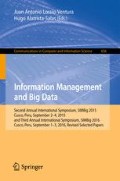Abstract
Expressions, such as add fuel to the fire, can be interpreted literally or idiomatically depending on the context they occur in. Many Natural Language Processing applications could improve their performance if idiom recognition were improved. Our approach is based on the idea that idioms and their literal counterparts do not appear in the same contexts. We propose two approaches: (1) Compute inner product of context word vectors with the vector representing a target expression. Since literal vectors predict well local contexts, their inner product with contexts should be larger than idiomatic ones, thereby telling apart literals from idioms; and (2) Compute literal and idiomatic scatter (covariance) matrices from local contexts in word vector space. Since the scatter matrices represent context distributions, we can then measure the difference between the distributions using the Frobenius norm. For comparison, we implement [8, 16, 24] and apply them to our data. We provide experimental results validating the proposed techniques.
Access this chapter
Tax calculation will be finalised at checkout
Purchases are for personal use only
Notes
- 1.
These examples are extracted from the Corpus of Contemporary American English (COCA) (http://corpus.byu.edu/coca/).
References
Birke, J., Sarkar, A.: A clustering approach to the nearly unsupervised recognition of nonliteral language. In: Proceedings of the 11th Conference of the European Chapter of the Association for Computational Linguistics (EACL 2006), Trento, pp. 329–336 (2006)
Burnard, L.: The British National Corpus Users Reference Guide. Oxford University Computing Services, Oxford (2000)
Cacciari, C.: The place of idioms in a literal and metaphorical world. In: Cacciari, C., Tabossi, P. (eds.) Idioms: Processing, Structure, and Interpretation, pp. 27–53. Lawrence Erlbaum Associates, Hillsdale (1993)
Cilibrasi, R., Vitányi, P.M.B.: The Google similarity distance. IEEE Trans. Knowl. Data Eng. 19(3), 370–383 (2007)
Cook, P., Fazly, A., Stevenson, S.: Pulling their weight: exploiting syntactic forms for the automatic identification of idiomatic expressions in context. In: Proceedings of the ACL 2007 Workshop on A Broader Perspective on Multiword Expressions, pp. 41–48 (2007)
Cook, P., Fazly, A., Stevenson, S.: The VNC-tokens dataset. In: Proceedings of the LREC Workshop: Towards a Shared Task for Multiword Expressions (MWE 2008), Marrakech, June 2008
Cowie, A.P., Mackin, R., McCaig, I.R.: Oxford Dictionary of Current Idiomatic English, vol. 2. Oxford University Press, Oxford (1983)
Fazly, A., Cook, P., Stevenson, S.: Unsupervised type and token identification of idiomatic expressions. Comput. Linguist. 35(1), 61–103 (2009)
Feldman, A., Peng, J.: Automatic detection of idiomatic clauses. In: Gelbukh, A. (ed.) CICLing 2013. LNCS, vol. 7816, pp. 435–446. Springer, Heidelberg (2013). doi:10.1007/978-3-642-37247-6_35
Fellbaum, C., Geyken, A., Herold, A., Koerner, F., Neumann, G.: Corpus-based studies of German idioms and light verbs. Int. J. Lexicogr. 19(4), 349–360 (2006)
Firth, J.R.: A synopsis of linguistic theory, 1930–1955 (1957)
Fukunaga, K.: Introduction to Statistical Pattern Recognition. Academic Press, New York (1990)
Glucksberg, S.: Idiom meanings and allusional content. In: Cacciari, C., Tabossi, P. (eds.) Idioms: Processing, Structure, and Interpretation, pp. 3–26. Lawrence Erlbaum Associates, Hillsdale (1993)
Hearst, M.A.: Automatic acquisition of hyponyms from large text corpora. In: Proceedings of the 14th Conference on Computational Linguistics (COLING 1992), vol. 2, pp. 539–545. Association for Computational Linguistics, Stroudsburg (1992). http://dx.doi.org/10.3115/992133.992154
Katz, G., Giesbrecht, E.: Automatic identification of non-compositional multiword expressions using latent semantic analysis. In: Proceedings of the ACL/COLING-06 Workshop on Multiword Expressions: Identifying and Exploiting Underlying Properties, pp. 12–19 (2006)
Li, L., Sporleder, C.: Using Gaussian mixture models to detect figurative language in context. In: Proceedings of the NAACL/HLT 2010 (2010)
Mikolov, T., Chen, K., Corrado, G., Dean, J.: Efficient estimation of word representations in vector space. In: Proceedings of Workshop at ICLR (2013)
Mikolov, T., Sutskever, I., Chen, K., Corrado, G., Dean, J.: Distributed representations of words and phrases and their compositionality. In: Proceedings of the NIPS (2013)
Nunberg, G., Sag, I.A., Wasow, T.: Idioms. Language 70(3), 491–538 (1994)
Pado, S., Lapata, M.: Dependency-based construction of semantic space models. Comput. Linguist. 33(2), 161–199 (2007)
Peng, J., Feldman, A., Vylomova, E.: Classifying idiomatic and literal expressions using topic models and intensity of emotions. In: Proceedings of the 2014 Conference on Empirical Methods in Natural Language Processing (EMNLP), pp. 2019–2027. Association for Computational Linguistics, Doha, October 2014. http://www.aclweb.org/anthology/D14-1216
Sag, I.A., Baldwin, T., Bond, F., Copestake, A., Flickinger, D.: Multiword expressions: a pain in the neck for NLP. In: Proceedings of the 3rd International Conference on Intelligence Text Processing and Computational Linguistics (CICLing 2002), Mexico City, pp. 1–15 (2002)
Seaton, M., Macaulay, A. (eds.): Collins COBUILD Idioms Dictionary, 2nd edn. HarperCollins Publishers (2002)
Sporleder, C., Li, L.: Unsupervised recognition of literal and non-literal use of idiomatic expressions. In: Proceedings of the 12th Conference of the European Chapter of the Association for Computational Linguistics (EACL 2009), pp. 754–762. Association for Computational Linguistics, Morristown (2009)
Villavicencio, A., Copestake, A., Waldron, B., Lambeau, F.: Lexical encoding of MWEs. In: Proceedings of the Second ACL Workshop on Multiword Expressions: Integrating Processing, Barcelona, pp. 80–87 (2004)
Widdows, D., Dorow, B.: Automatic extraction of idioms using graph analysis and asymmetric lexicosyntactic patterns. In: Proceedings of the ACL-SIGLEX Workshop on Deep Lexical Acquisition (DeepLA 2005), pp. 48–56. Association for Computational Linguistics, Stroudsburg (2005). http://dl.acm.org/citation.cfm?id=1631850.1631856
Acknowledgements
This material is based upon work supported by the National Science Foundation under Grant No. 1319846.
Author information
Authors and Affiliations
Corresponding author
Editor information
Editors and Affiliations
Rights and permissions
Copyright information
© 2017 Springer International Publishing AG
About this paper
Cite this paper
Peng, J., Feldman, A. (2017). Automatic Idiom Recognition with Word Embeddings. In: Lossio-Ventura, J., Alatrista-Salas, H. (eds) Information Management and Big Data. SIMBig SIMBig 2015 2016. Communications in Computer and Information Science, vol 656. Springer, Cham. https://doi.org/10.1007/978-3-319-55209-5_2
Download citation
DOI: https://doi.org/10.1007/978-3-319-55209-5_2
Published:
Publisher Name: Springer, Cham
Print ISBN: 978-3-319-55208-8
Online ISBN: 978-3-319-55209-5
eBook Packages: Computer ScienceComputer Science (R0)

